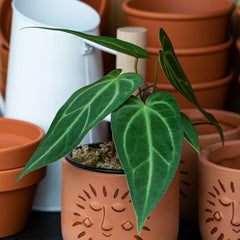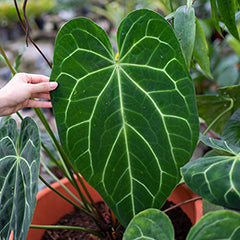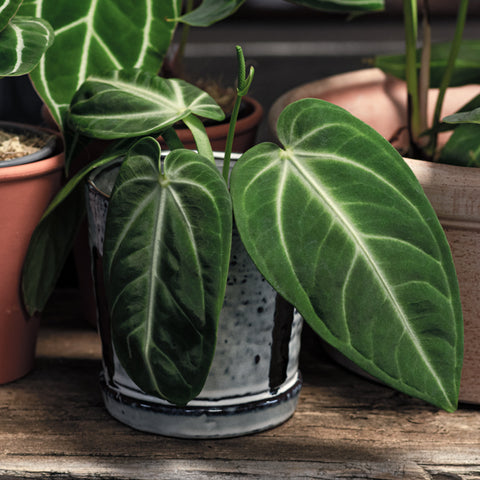Care of anthuriums
The anthurium is a popular plant with collectors and makes an excellent gift for any tropical plant lover. Part of the Araceae family, anthuriums have nearly a thousand diverse cultivars and include epiphytic, semi-epiphytic and terrestrial plants.
Easy to care for, these plants offer a variety of specimens to suit all tastes, which will never cease to impress with their beautiful leaves and flowers of varying colours and textures.
History & origins
Natural environment
Plant Care & Advice
Watering
Soil
Flowering
Temperature
Fertiliser
Lighting
Toxicity
Species
History & origins

Anthuriums were among the first ornamental plants to find their way into European homes in the late 1800's. At that time it was common to find beautiful specimens ofAnthurium crystallinum andAnthurium regale as a decorative piece among a variety of other plant types.
The generic name, Anthurium, is derived from the Greek words anthos and oura. A literal translation would be 'flowering tail': a very appropriate name given its inflorescence consisting of a spathe and spadix on which the flowers are located. Because of this type of inflorescence, the genus Anthurium has been classified as belonging to the Araceae family.
Natural environment

Anthuriums come from South and Central America. The vast majority of the finest specimens are found on the western slopes of the Andes, in the rainforests of Ecuador and Colombia. Other specimens are also found in southern Mexico and the West Indies.
Since anthuriums usually grow in tropical rainforests, they receive water on a daily basis. Anthuriums usually grow on trees, which means that rain falls on the plants and drains off very quickly so that no water accumulates around the roots. This allows the roots to receive water while remaining exposed to the air. This combination of elements is necessary to prevent the growth of harmful organisms.
You may have wondered how epiphytic anthuriums ended up growing in trees. The answer is simple: birds! They eat the seeds in their droppings, which then fall onto the tree branches. The anthuriums have just enough nutrients (from the bird's excrement) to start their life cycle.
Taking good care of your anthurium: maintenance & advice
Understanding the differences between epiphytic, hemipiphytic and terrestrial anthuriums
In order to fully understand and master the care of your anthuriums, it is essential to know how to differentiate between the different types and varieties. This is an excellent indicator of where they come from and their specific needs, which can help to reproduce an ideal environment.
Epiphyte
Epiphytes are plants that grow by clinging to other plants or surfaces, such as tree bark or rock faces. Since they do not grow on the ground, these plants get their nutrients from the air, water and debris around them. Since epiphytic Anthuriums do not acquire their nutrients from the soil like their terrestrial cousins, they have developed a number of unique adaptations to survive this nutrient-poor environment. These plants also generally require more moisture and frequent watering.
Hemiepiphyte
While many people know what an epiphytic plant is, hemipiphytic plants are less well known. Hemiepiphytic plants are plants that start their life cycle on the ground and then continue to grow on a tree or other support. This type of anthurium will even go so far as to move away from the light (knowing that it will easily be able to find it again), in order to cling to a tree. Hemipiphytic anthuriums will benefit from a stake to enable them to climb and grow healthily.
Terrestrial
As you may have guessed, ground anthuriums do not depend on other plants to grow. They grow on the ground, without assistance to support themselves. This type of anthurium requires light, airy soil and less frequent watering to provide a suitable environment for root development.
How to water your anthurium
The key to successful anthurium care is watering. It is necessary to give them regular watering while allowing the roots to get air. We recommend watering enough to keep the soil moist at all times, without getting soggy, in a pot that allows for effective drainage. By using a well aerated potting soil, excessive watering can be avoided. It is recommended that the plant be sprayed regularly to maintain good humidity. It is also possible to place your anthurium on a tray filled with water and clay balls to increase the humidity around the plant. Note, however, that it is important not to let the leaves of the plant come into contact with the water!
Choosing the right soil for your anthurium

If you were to visit a tropical rainforest, you would find that the soil is mostly composed of dead leaves, decaying wood, compost and charcoal left behind by forest fires. By making sure you choose the right soil for your anthurium, you are providing it with an environment that resembles its natural state and is therefore conducive to its growth.
This is accomplished by using a potting soil that is light, airy and drains well, such as our Hoyas and Aroids potting soil. You can also make your own mix by starting with a quality potting soil and adding a variety of substrates to create the perfect texture. We recommend starting with a mix of approximately 20% high porosity potting soil, 20% coconut fibre and 20%black pine bark. Then add 10% sphagnum moss, 10% clay balls, 10% perlite and 10% pumice. Optionally, you can also add about 10% activated charcoal to control humidity and temperature variations and to help resist fungal diseases.
Elements such as potting soil, coconut fibre, bark and sphagnum moss retain moisture and release it slowly, while clay balls, perlite, pumice and charcoal provide aeration to the mix and help roots grow healthy. The pine bark eventually decomposes, creating organic matter that enriches the soil. The roots of your anthurium will then get all the moisture they need while being able to dry and move easily in their pot.
Flowering and pollination of anthuriums

Some anthurium cultivars produce flowers freely at any time of the year, while others reproduce only during a particular season.
Although many anthurium species have what looks like a waxy flower, it is actually a spathe or modified leaf that wraps around the flower and helps pollinators find them. It serves to protect the spadix, which contains several small flowers when in bloom. The spathe comes in a variety of colours, including red, pink, orange and white.
The flowering of anthuriums has an impressive feature. The female part matures first, so that the pollinator can deposit pollen on it, allowing the plant to acquire genetic material from another flower. The cycle starts again, when the insect emerges from the female flower, rubbing against the pollen of the male flowers, and then goes on to pollinate another plant. The vast majority of the flowers of the various anthuriums also produce red or white berries (depending on the species).
Maintaining an ideal temperature for your anthurium
Given its origin, your anthurium requires a comfortable temperature to grow healthy. Cold weather below 15°C can drastically reduce the growth rate of your plant and cause the leaves to turn yellow. The ideal temperature for anthuriums is between 20 and 32 °C, depending on the species. It is also important to be wary of direct sunlight, which can burn and dry out the leaves. The ambient humidity of the plant should be between 60 and 80%, depending on the species. Some of them can survive with less humidity, such as the classic red flowered anthurium.
Fertilizing your anthurium
Anthuriums need a lot of trace elements (very small amounts of iron, zinc, etc.), and minor elements (such as magnesium), as well as the main elements (NPK, nitrogen, phosphorus, potassium, etc.). Since many of them are epiphytes, or hemiepiphytes, they absorb these elements through rain and other elements in passing (e.g. debris from volcanoes, which contains minerals, nitrogen which becomes available after lightning). It can be interesting to fertilize directly on the leaves, but this is done with a very light mist (since at home there is not enough wind to dry them quickly).
In our production of rareanthuriums, we mainly use Stimyla as fertiliser. We like to use it because it is composed of five living algae. It is a phytostimulant from the Magdalen Islands, comparable to superfoods for us (such as kale). It is more complete than Acadia algae, but can be used in tandem to increase the amount of nitrogen and potassium needed by the plants. Stimyla can only be used during the active growth period of the plant, and it is important to filter it before each use so as not to clog your sprayer. If the plant receives too much of this fertilizer, it will stop growing because it will not have time to remove the excess elements. This is another reason why it is good to alternate with Acadia, which is milder and will not cause this phenomenon.
Providing adequate lighting for your anthurium

Regular bulbs simply do not provide enough intensity or the right spectrum to keep a specimen anthurium happy and healthy. Grow lights may be able to make them "grow", but will probably not make them flourish.
What differentiates the anthurium (as well as the Spatiphyllum) from other Araceae is the geniculum. This is a part on the petiole at the base of the leaf that allows the leaf to move towards the light. Most anthuriums are able to detect light!
Is my anthurium poisonous?
The sap and tissues of anthuriums are toxic to humans and animals due to the presence of calcium oxalate crystals. A strong burning sensation and inflammatory reaction may occur if ingested or chewed, including blistering and swelling. It is therefore important to keep your anthuriums out of the reach of children and pets.
The most beautiful anthurium species
Anthurium veitchii (king of anthuriums)
Anthurium veitchii, also known as the 'king of anthuriums', was one of the first anthuriums recorded. It was discovered by Gustav Wallis who brought it to his employer James Veitch and sons, hence the name: veitchii. Its leaves can grow up to 6 feet long in its natural habitat under optimal conditions.


Anthurium warocqueanum (queen of the anthuriums)
Anthurium warocqueanum was discovered in 1874, together withAnthurium veitchii, by the same plant collector, Gustav Wallis. Its name means 'Empress of the Jungle' in Latin and it is affectionately known as the 'Queen of Anthuriums'. In its natural environment, the leaves can grow up to 6 feet long and have a velvety texture and metallic veining. The appearance of the leaves can vary from plant to plant, as well as on the same specimen (a fairly common feature of anthuriums).


Anthurium andreanum (Flamingo Lily, Painter's palette)
Anthurium andreanum, also known as 'Flamingo Lily' or 'Painter's Palette', is one of the most popular and recognisable houseplants on the market. Requiring less moisture than some other species, it has quickly become a favourite with anthurium lovers! The iconic leaves and flowers are often cut and used in floral arrangements, and come in a range of colours depending on the variety or hybrid of anthurium.

Anthurium clarinervium (Velvet Cardboard Anthurium)
Anthurium clarinervium is a plant loved by collectors and plant lovers. It produces dark green heart-shaped leaves with a velvety finish, deeply lobed and contrasting white veins. Its distinct characteristics give it an exotic look that will stand out in any setting.

Anthurium crystallinum (Crystal Anthurium)
The leaves of this beautiful tropical plant are heart-shaped, dark green or reddish purple with deep white veins that provide a beautiful contrast.Anthurium crystallinum is a close relative of clarinervium. The main difference is thatAnthurium crystallinum has more elongated heart-shaped leaves, whileAnthurium clarinervium produces rounder, bubble heart-shaped leaves.


Anthurium forgetii
One of the most notable features ofAnthurium forgetii is its lack of a sinus opening at the apex of the leaf blade (a trait most anthurium species possess).Anthurium forgetii has round, velvety leaves with complex, contrasting veins that stand out in any plant collection.


Anthurium hookeri (Bird's Nest Anthurium)
Anthurium hookeri, also known as 'bird's nest' anthurium because of its rosette-like structure, produces wrinkled leaves that have an almost cardboard-like texture in a lush, full green colour. In the wild,Anthurium hookeri is epiphytic (i.e. it grows without soil, in forest debris), making it a unique addition to your plant collection.

Anthurium radicans x luxurians
Anthurium luxurians and Anthurium radicans are beautiful species that produce unique textured and bubbled heart-shaped leaves. Hybrid varieties are often found as a result of crosses between the two species. When the plants are young, the newly developing leaves are dark red. As the plant matures, the leaves turn a beautiful chocolate colour, then darken further to forest green. Their unique flowers range from pink to brown, giving an exotic feel to any room or setting.

Anthurium magnificum
An exotic aroid grown for its beautiful foliage,Anthurium magnificum is known for its large, velvety, dark green leaves with contrasting white veins. Its leaves can also grow to an astonishing size in their natural environment, up to 3 feet long and 2 feet wide! The plant also flowers amazingly throughout the year with well developed bisexual flowers.


Anthurium pendulifolium
Its long, ruffled leaves make theAnthurium pendulifolium an interesting addition to any plant collection. This plant loves the heat and instantly creates a tropical atmosphere in your home.Anthurium pendulifolium has thin, blade-like leaves that can grow up to 4 feet long in its natural environment and hang downwards, making it ideal for hanging baskets.
Anthurium regale
Anthurium regale produces heavily veined heart-shaped leaves that start out pale in colour and evolve to a darker green and velvety texture over time. This exotic plant is known for its incredible ability to reach a total height of about 6 feet in the right environment!

Anthurium villenaorum
Anthurium villenaorum is known for its long, beautiful and bold dark green leaves. A pattern of white veins adds contrast to the unique semi-velvety textured leaves.

Anthurium faustomirandae
The huge, fascinating leaves of Anthurium faustomirandae grow on long petioles but do not have the velvety texture common to other species. The new leaves appear with a red to gold colouration and have a glossy finish. As they mature, the leaves become leathery and matte or even rubbery.


